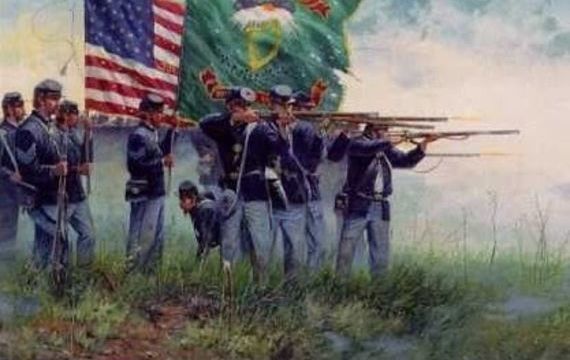On Aug 20, 1861, the 80 Irishmen of F company Phillips Legion (known as the Lochrane Guards), a unit of the Confederate Army, boarded a Macon and Western railway train and rode into history.
It was a festive occasion. Hundreds of family members and well-wishers, complete with a brass band, turned out to see the cream of the Irish community off to war.
The six companies of Phillips Legion eventually were assigned to the 24th. Georgia under the command of Colonel Robert McMillan, from Northern Ireland. Early in December 1862, the 24th held a defensive position overlooking the town of Fredericksburg, known as Marye's Heights. Well dug in on a sunken road behind a stone wall and supported above by the infamous Washington Artillery they awaited General Burnsides Union army of the Potomac.
The assault on Marye's Heights began on Dec 13. Four brigades of union soldiers were repulsed with heavy losses. Their dead and wounded scattered along the Heights. Then in the distance appeared the green flag of the Irish brigade. If General Lee had any doubts about his Irish troops firing on their fellow Irishmen he was soon to be reassured.
Read more
The Irish Brigade assembled in battle order as best they could under the long-range guns of the Washington Artillery who cut large gaps in their formations. Still, they came.
At 300 yards on the double-quick, the short-range artillery opened up. Still, they came. At 150 yards Colonel McMillan gave the order to fire and a thousand rifles and muskets destroyed whatever vigor was left in the Irish Brigade.
When the firing stopped and the men behind the wall realized the attack was over, the Lochrane Guards and their fellow soldiers rose threw their hats in the air, and gave the Irish Brigade a great Hurrah for their courage and bravery. They were stopped forty yards from the wall.
On the night after the battle [ according to a New York newspaper ] a union soldier Captain Dowling in an effort to cheer up his troops began to sing his party piece "The song from Backwoods" a well-known song about Irish immigrants. Soon his regiment joined in, then the division, and soon the singing was heard all along the six-mile union front and echoed by their fellow Irishmen on the other side of the Rappahannock River.
Only three Irishmen from the Lochrane Guards were let to surrender two and a half years later at Appomattox.

Love Irish history? Share your favorite stories with other history buffs in the IrishCentral History Facebook group.

Love Irish history? Share your favorite stories with other history buffs in the IrishCentral History Facebook group.
This article was submitted to the IrishCentral contributors network by a member of the global Irish community. To become an IrishCentral contributor click here.




Comments